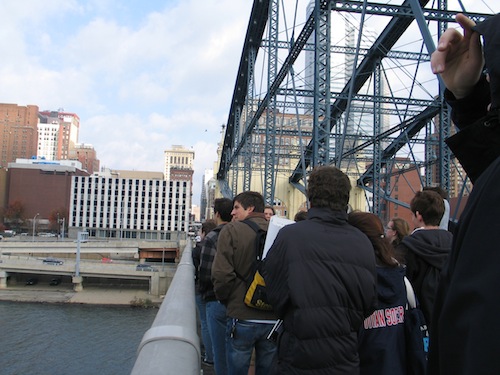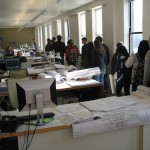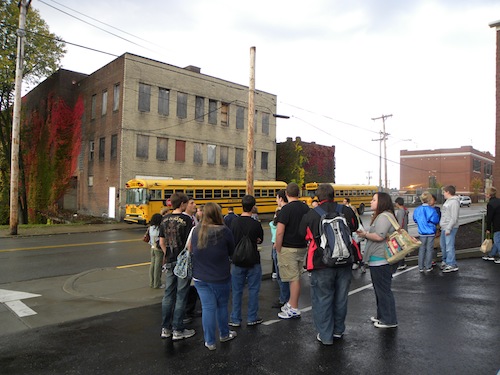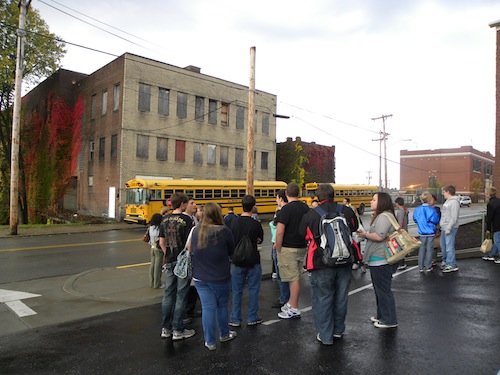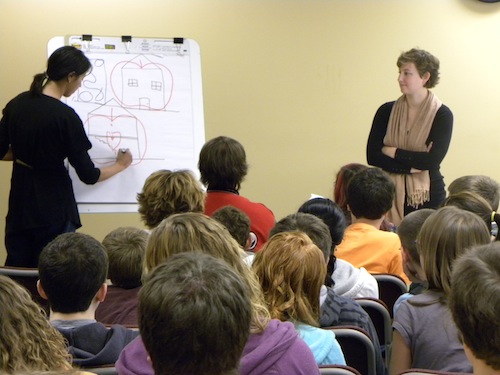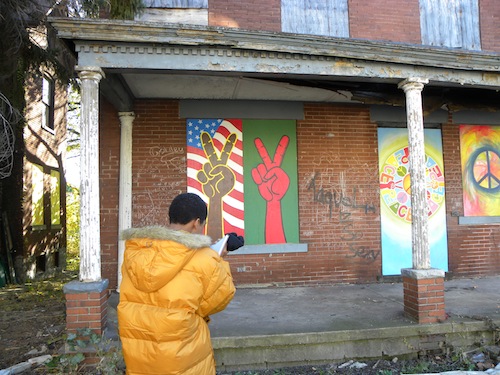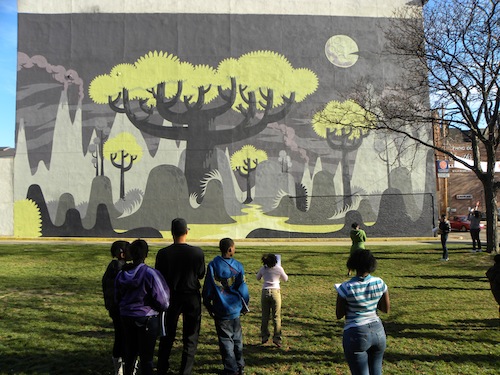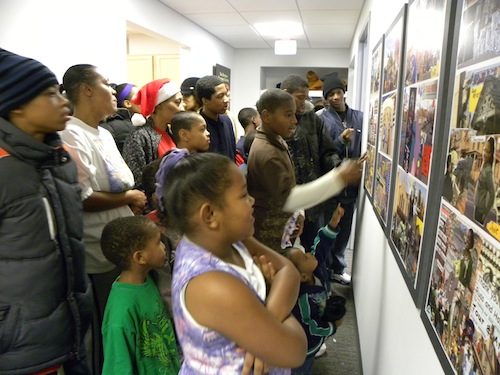
Latest News
-
PHLF in 2010
This year, we had more than 10,000 people participate in creative educational classes, public tours, and special events offered by our staff, with the help of many dedicated volunteers. We had a splendid “Legends and Landmarks” evening at Oakmont Country Club, where Carol Semple Thompson was honored with our Living Landmark award for her contributions to golf and preservation. We also enjoyed an evening reception at the Lehn’s historic Fifth Avenue home, honoring those who have been members of PHLF for 25 years or more.
In 2010, we fully leased Market at Fifth and we have begun to assemble the funding for a creative reuse of our fourth building downtown— the Thompson Building. Renovation is scheduled to begin in the coming months. Work in Manchester continues with the Manchester Citizens Corporation, restoring seven historic houses with funding from PHLF and the Urban Redevelopment Authority.
We also reached an agreement with the City of Pittsburgh for them not to demolish any more historic houses in Manchester until a plan is in place. We also continue to engage the City in further analysis of how to increase restoration and reuse of historic buildings in downtown.
As a result of over three years of effort by many parties, work began on the Crescent Apartment and Wilson House, for an affordable housing restoration project in Wilkinsburg. We completed all of the negotiations and acquisitions for the next phase of restoring derelict houses and planting vacant lots, and we opened our Housing Resource Center to serve Southwestern Pennsylvania homeowners with educational programs.
Our Allegheny Together Main Street program with Allegheny County has created considerable investment in building restoration, in developing new businesses, and in upgrading existing ones. The same is true for our Main Street programs in Vandergrift, Freeport, Leechburg, and Apollo. In Pittsburgh, we continue to work with North Side residents and the cultural institutions there on opening some of the historic streets in Allegheny Center.
Our Historic Religious Properties Program of financial and technical assistance was reactivated, thanks to a generous challenge grant from two PHLF members and many matching gifts from members and friends. In 2010, we accepted an easement for the oldest office building downtown, the Burke Building (John Chislett, architect, 1836), resulting in the preservation of the building’s façade in perpetuity.
The Civic Arena presented enormously complicated problems. We talked with many groups: those who feel that it absolutely must be saved; those who feel it absolutely must be demolished; the Hill District residents; the Sports and Exhibition Authority (SEA); the Penguins; and the National Trust for Historic Preservation. Ultimately, we articulated our position in the paper that we published in October 2010. We desire to see the Federal Statute called “Section 106” honored in order for SEA to see the process through to a sound solution.
All in all, I have tried to demonstrate how the foundations have been laid for a productive 2011. And, as the New Year begins, we are eager to hear from you as to your priorities for historic preservation in Southwestern Pennsylvania.
Arthur Ziegler
President
Pittsburgh History & Landmarks Foundation
-
Wilkinsburg Celebrates New Developments
On October 12th, PHLF held a press conference at the Landmarks Housing Resource Center in Wilkinsburg to announce the commencement of four major initiatives.
In the span of one year, these initiatives will bring nearly $10 million to the community and will result in two fully restored apartment buildings, three restored single-family homes which would represent the second phase of housing in Hamnett Place, the start of year three of the Neighborhood Partnership Program, and the launch of the Landmarks Housing Resource Center.
County Executive Dan Onorato, an important funder and supporter of the housing work ongoing in Wilkinsburg, stated that, “In working with these public and private partners for the last four years, we have demonstrated our commitment to the revitalization of Wilkinsburg. We have renovated homes and developed commercial property, all while preserving the historic feel of this community. We know that businesses and housing go hand-in-hand with economic revitalization.”
Brian Hudson, executive director of the Pennsylvania Housing Finance Agency, a major funder of the Crescent and Wilson restoration development, also stated that by “working together, we will be able to restore these historic buildings and not only provide affordable housing, but also provide supportive services for the new residents.”
Speakers at the press conference also lauded the success of the past two years of the Neighborhood Partnership Program, an initiative of the PA Department of Community and Economic Development, and talked about the programming for the upcoming year. With funding from TriState Capital Bank, which has committed $2 million dollars over a seven-year period, the Wilkinsburg Community Development Corporation and the Pittsburgh History & Landmarks Foundation will use the funds for initiatives ranging from vacant lot management, to programming for the Landmarks Housing Resource Center, to clean and green programs on the Wilkinsburg main street.
Lastly, the site for the press conference, the Landmarks Housing Resource Center, was praised by attendees as being a new important ingredient for community revitalization in Wilkinsburg and beyond. The HRC is located in the heart of Hamnett Place across from the Crescent Apartments. Programming throughout the year, will focus on workshops and seminars ranging from how to restore your historic home, how to acquire and improve a vacant lot, and to how to make your home more energy efficient.
-
Golden Triangle Buildings Could Get Face-Lifts
Sunday, December 26, 2010
By Mark Belko, Pittsburgh Post-GazetteThe city is looking to brighten up some “dark corners” Downtown.
Aided by a $4 million state redevelopment assistance grant, the Urban Redevelopment Authority hopes to target rundown buildings Downtown and work with property owners to upgrade them.
The project is designed to supplement a larger revitalization in the Golden Triangle that already has included the construction of the Three PNC Plaza office tower and the redevelopment of a former five-and-dime store and a department store into residential, retail and other uses.
With much of that work completed, the URA has decided to go after properties “in need of some reinvestment” — not to buy but to approach and work with the owners about making improvements.
“This is really a building-by-building, block-by-block approach,” said Yarone Zober, URA board chairman and chief of staff to Mayor Luke Ravenstahl.
Mr. Zober said the genesis for the idea came during walks he and Mr. Ravenstahl had Downtown.
“One thing the mayor and I noticed at street level were individual buildings that needed work … or didn’t have street-level appeal. They detracted from the general feel and look of the Downtown corridor,” he said.
“It became very clear that we needed new tools to continue the revitalization of Downtown.”
Funds from the grant, awarded by Gov. Ed Rendell earlier this month, can be used to make facade improvements or to address “life safety” issues that prevent property owners from using upper floors for residences or other purposes.
Life-safety improvements could include stairwells, elevators or other measures to bring buildings up to code. URA executive director Rob Stephany said such improvements typically run $250,000 at the minimum.
While projects like Three PNC, Piatt Place and Market Square Place have helped to transform Downtown, there are other buildings still in need of work, including some near the upscale Capital Grille restaurant at Fifth Avenue and Wood Street, Mr. Stephany said.
“You go to wait for the valet to bring your car back and there’s blight staring you in the face,” he said.
Properties the city initially is targeting for possible work include the Thompson Building on Market Street between Fifth and Market Square and a building owned by the Order of Italian Sons & Daughters of America at Wood and Forbes Avenue that once housed a McDonald’s restaurant.
Also on the list are three buildings at the western corner of Fifth and Wood that house a jewelry store and other retail outlets and a couple of buildings on Wood owned by the URA itself.
Mr. Zober said the URA already has had discussions with the property owners about potential improvements.
David Kashi, owner of the Fifth and Wood properties, said he hopes to secure funds to upgrade the facades of the buildings. He plans to install new windows and perhaps add a marquee to the front of the buildings. He also is thinking about placing a “big clock” on the corner building.
“We’re going to make Downtown beautiful,” he said.
Mr. Kashi said he already has had one meeting with the URA and plans to have another next month to work out plans and budgeting. He had no estimate for the cost of improvements.
He likes the city initiative.
“Downtown is the center of the whole Pittsburgh area. I think it’s about time someone took the initiative and improved the look. Nothing has changed in 50 or more years,” he said.
Improving the overall ambiance also “attracts investors to bring money into Downtown Pittsburgh,” he said.
The program will require property owners to match amounts received from the URA. Mr. Kashi is not thrilled about having to do so but said he would to increase the value and curb appeal of his properties.
The Thompson Building, which once housed the Ciao Baby restaurant, is owned by the Pittsburgh History & Landmarks Foundation, which already has redeveloped three adjoining buildings at Market Street and Fifth.
Arthur Ziegler Jr., president of the foundation, said the organization plans to restore the facade of the Thompson Building, which likely will play host to some type of restaurant, bar or cafe.
Mr. Ziegler said the building once housed a restaurant operated by the Chicago-based Thompson restaurant chain. The chain at one time had six restaurants in Pittsburgh, but the Market Square building is the only one that has survived.
It was purchased by John R. Thompson in 1926, but dates back farther than that, perhaps to the turn of the century.
“It is an important part of Pittsburgh history,” Mr. Ziegler said.
Besides restoring the exterior, the foundation will “try to meet the green standards that we’ve established down there and we want to get the building in service as soon as possible in 2011,” he said.
The foundation spent $3 million restoring the original facades of the three adjoining buildings, which house a men’s clothing store, a shoe store and apartments. It plans to make a substantial investment in the Thompson Building but also is looking for help from the URA to fill in the gap.
“We did not do that with the first three buildings. We provided the funds. We need some help with this fourth one,” Mr. Ziegler said.
Like Mr. Kashi, Mr. Ziegler believes there is a need for the type of program the URA is starting.
“I think it’s excellent. We need to continue to recognize the value of these historic buildings and improve their exteriors and their basic interiors to meet building codes,” he said.
At the site of the former McDonald’s restaurant, the city would like to remove the burnt-orange metal facade that covers the upper floors and restore the building’s original exterior.
Mr. Ziegler said that underneath the current facade the building features an attractive stone architecture. “It was a handsome corner and we would like to see it be that again,” he said.
Officials at the Order of Italian Sons and Daughters could not be reached for comment.
While the URA has targeted some real estate, any Downtown building owner interested in upgrading a property can contact the agency about possible aid, Mr. Zober said.
The city’s effort is unrelated to six acquisitions totaling $15.15 million made by an unidentified buyer on the east side of a block bordered by Wood, Fifth and Forbes over the past eight months.
While the identity of the buyer is not known, many in the real estate community believe it is PNC Financial Services Group, which built Three PNC Plaza. A PNC spokesman has said, “We don’t comment on speculation.”
There’s much talk that the block could be the site of the next big development Downtown. In the meantime, the city is hoping to fill in the cracks.
“Our goal is to really make Downtown look complete,” Mr. Zober said.
-
More than 10,000 People Participated in PHLF’s 2010 Educational Programs
-
New Tax Law Extends Charitable IRA Rollover for 2010 and 2011
On Dec. 17, President Barack Obama signed the Tax Relief, Unemployment Insurance Reauthorization and Job Creation Act of 2010. Included in the package is an extension of charitable IRA rollovers. Here are some important provisions to note:
- Individuals age 70 ½ and older may once again request direct transfers of funds from Individual Retirement Accounts (IRAs) to Landmarks without income tax on gifted funds.
- The funds must be directly transferred from IRA accounts to Landmarks (donors should ask their IRA custodians for special forms to make these requests).
- Each individual is entitled to make a total of $100,000 in gifts to charities each year under this provision.
- If you have not yet taken your IRA Required Minimum Distributions (RMDs) for 2010, you may partially or wholly satisfy that requirement through an IRA rollover gift made by January 31, 2011.
- These contributions do not qualify donors for an additional charitable income tax deduction as not being taxed on the withdrawal is worth even more than a standard charitable deduction.
- Only standard IRAs and Roth IRA accounts qualify under this law; other retirement accounts such as 401(k), 403(b), SEP, KEOGH, and SIMPLE IRA plans cannot be used to make an IRA rollover gift.
- Donors of IRA rollover gifts must receive no personal benefits from this gift nor are they available for planned gifts such as charitable remainder trusts or gift annuities.
The provision is a significant opportunity for donors who:
- Hold assets in their IRAs that they do not need;
- Would like to make a large one-time gift;
- Are subject to the two-percent rule that reduces itemized deductions;
- Do not itemize; or
- Plan to leave part or all of their IRA to Landmarks at death.
For more information on how the Charitable IRA Rollover may be beneficial to you and Landmarks, please contact our Director of Gift Planning, Jack Miller, at 412-471-5808, ext. 538 or jack@phlf.org.
-
Collier to Preserve Historic Photographs
Thursday, December 23, 2010
By Carole Gilbert BrownThe decision by Collier commissioners to spend $1,134.20 to scan and frame historical township photographs is an award winner for Gene Czambel, 67, of Steen Hollow Road.
Mr. Czambel, a lifelong resident who traces his family’s roots in Collier back to 1882, has been on a crusade for several years to preserve the township’s history through photographs and other memorabilia.
He has offered 16 photos from the Beechmont area and beyond to be scanned and framed so that residents can view them in the township building and the Nike Site property. Many date back to the early 20th century and late 19th century.
If the township forms a historical society, he promises to donate the originals, as well as about 30 more historical photographs.
“I have a museum here between my dad, grandfather and great-grandfather,” he said.
But, with no descendants, he adds, “When I’m gone, it’s gone.”
Among the approximately 50 photos are shots of the Pittsburgh Coal Co.’s Essen No. 2 Mine in Burdine, a photograph of the now-gone Beechmont School with his mother shown, too, as well as pictures of the former town of Hickman, which was named after farmer Joseph Hickman but developed by Mr. Czambel’s great-grandfather, who was an engineer and entrepreneur.
Burdine, Beechmont and Hickman have been incorporated into what is now Collier.
The town burned down in a fire, but included at one time a post office, store, and a hotel with a bar. Mr. Czambel even has photographs of the fire.
Mr. Czambel has donated photographs to other area communities, too, including Bridgeville, Carnegie and Oakdale.
Besides photographs, he possesses historical memorabilia, too. For example, the cement pads that once were in front of the boys’ and girls’ outhouses at Beechmont School are now in his front yard.
Anyone interested in donating historical photographs or memorabilia, or in helping to form a historical society, should contact the township.
-
Blast From the Past: Old Steel Mill Forges New Life as a Park
Ben Muessig
AOL News(Dec. 2) — Preservationists outside Pittsburgh are fighting to put an abandoned steel mill back to work — not so it can produce metal, but so it can protect history.
Since the blast furnaces fired up for the last time at the Carrie Furnace in 1978, the decaying steel mill on the bank of the Monongahela River has served as a solemn reminder of the industry that turned Pittsburgh into a thriving city — then left it polluted and jobless.
Now, more than three decades after the Carrie Furnace went from being a bustling workplace for 4,000 employees to a 168-acre ghost town, a team of preservationists is trying to convert the remains of the hulking factory in Rankin, Pa., into a museum dedicated to the region’s steel history.
“Pittsburgh is known for steel,” said Sherris Moreira, a spokeswoman for Rivers of Steel Heritage Corp., the group spearheading the preservation project. “There is this pride that people here have for their steel heritage — and this is a tangible way for people to connect with that history.”
Rivers of Steel hopes to preserve the remaining structures, transforming the industrial ruin into an interactive historical center inside a park.
At the heart of the proposed preservation project are the two remaining blast furnaces, which were built in 1907 and left largely unchanged until U.S. Steel halted operations at the Carrie Furnace.
The massive ovens are rare examples of pre-World War II steel-making technology — and they could make the perfect centerpiece for the proposed museum, according to Rivers of Steel curator of collections Tiffani Emig.
“They were never invested in for improvements and they were never upgraded. Everything was done by hand up until the day it closed,” Emig said. “That’s what makes them special.”
Those industrial relics — along with five other furnaces that were demolished — manufactured as much as 1,200 tons of iron per day, creating metals used in the construction of the Empire State Building and St. Louis’ Gateway Arch.
When the blast furnaces were operational, they turned ore, coke and limestone flux into a molten metal that was transported by rail across the aptly named “Hot Metal Bridge” to U.S. Steel’s Homestead Works, where it was converted into steel.
The Homestead Works were razed in 1988 and the site was converted into a shopping mall in 1999. Today, all that remains of the historic steel mill are the smokestacks, which tower over a movie theater parking lot across the river from the Carrie Furnace.
The Carrie Furnace has already been deemed a National Historic Landmark, meaning it likely won’t meet the same fate as the Homestead Works. But that doesn’t mean the site isn’t in danger.
When industry moved out, nature moved in. Tree roots have undermined the stability of some Carrie Furnace buildings, and grapevines scale the superstructure of the sprawling mill. Foxes, hawks and deer have recently been spotted on the site — and they’re not the only new visitors.
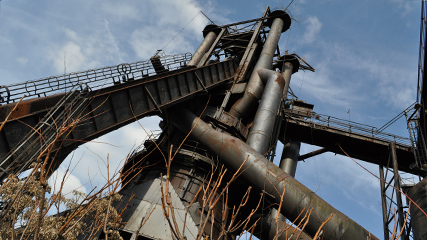
Since U.S. Steel halted operations at the Carrie Furnace in 1978, nature moved in. Trees tangle their way through the plant, and grapevines crisscross the catwalks. Ben Muessig for AOL News
The abandoned steel mill has become a destination for graffiti artists, paintball players, vagrants and vandals who strip the site and sell the stolen scrap metal.
“The wiring and anything else that can be scrapped has been taken out,” said Emig, who told AOL News she’s often chased away uninvited visitors. “With the graffiti, the paint wears off. It’s the people who are physically stripping the site who are the problem.”
Rivers of Steel plans to restore some parts of the Carrie Furnace to look the way they did when the plant was operational. But other parts — like a massive sculpture of a deer head built from metal and wire in the 1990s by the Industrial Arts Co-Op — will remain as they are today.
“We will preserve some of the graffiti, definitely the deer,” Emig said. “This site didn’t die in 1978. This place continued to be used, and we want to show that.”
Even if Rivers of Steel gets its wish and is able to preserve the remaining steel mill structures, the rest of the 168-acre property could look very different in the coming years. Allegheny County owns the entire site and began renting the Carrie Furnace buildings to Rivers of Steel in May.
County officials are looking for builders interested in bringing light manufacturing and residential development to the rest of the grassy plot.
New businesses or homes near the old steel mill will certainly change the site’s context, but they won’t compromise the Carrie Furnace as a historic site, according to Emig.
“It’s already compromised,” she said. “There’s only two furnaces left; there used to be seven. You work with what you have.”
The most important thing the Carrie Furnace has is its historic site, according to Arthur Ziegler, president of the Pittsburgh History and Landmarks Foundation.
“We have saved artifacts from the mills — blowing engines, a Bessemer converter and so forth — but we had to relocate them,” Ziegler said. “But this will be the first time it’s all preserved on site.”
Obviously, making the dilapidated steel mill a safe destination for sightseers isn’t going to be easy — or cheap.
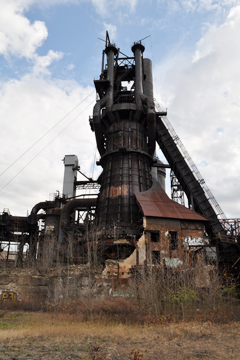
Turning the decaying steel mill into a park and history center won't be cheap -- but preservationists say residents of the "Steel City" are rallying behind their plan. Ben Muessig for AOL News
The group’s “bare-bones cost estimate” for the project is $78 million. Current funding only allows for repairs of a severely damaged roof at one of the powerhouses.
To fund other projects, like securing shaky catwalks, clearing out tons of debris from the mill’s stock house, or perhaps building a monorail like the one depicted in flashy conceptual images of the historic center, the group will seek public funding and private donations.
There’s talk of approaching the National Parks Service for help, but it’s unclear whether the cash-strapped agency would be interested in or able to offer assistance.
Though finances are a concern, Moreira says she’s been encouraged by the interest in the project.
“Heritage matters,” said Moreira, whose group has given tours of the Carrie Furnace to more than 700 eager visitors in the past two months. “It’s not only important to know where we come from, but it’s important looking to the future.”
In the years since the steel industry left Pittsburgh, the “Steel City” has in many ways attempted to distance itself from its metal-producing past. But the city’s industrial legacy lives on — and not just in the name of its football team and local beer.
According to Moreira, many Pittsburghers have started looking to the city’s steel-making roots as a source of pride.
“There was a lot of bitterness when the steel went away. People wanted to move on. But now people are at the point where they want to look back,” she said.
“This isn’t just steel; it’s about emotions.”
-
Washington County Farm on Statewide Danger List
Monday, December 20, 2010By Len Barcousky, Pittsburgh Post-GazetteA Washington County farm that has been operated by the same family for more than 200 years has been included on a list of 10 historic sites most at risk across Pennsylvania.
Longwall coal mining could harm several historic buildings at Plantation Plenty in Independence Township, according to Preservation Pennsylvania. The nonprofit organization released its list of endangered properties on Thursday.
State and federal environmental and preservation regulations require an analysis of the impact of commercial activities like mining on historic properties, according to Erin Hammerstedt, a field representative for Preservation Pennsylvania and the National Trust for Historic Preservation.
“Our goal would be to keep longwall mining out of this historic farm,” she said.
Preservation Pennsylvania is a private membership organization that seeks to protect historically and architecturally significant properties. The National Trust for Historic Preservation, created by Congress in 1949, plays a similar role across the country.
Plantation Plenty has been operated since 1800 by Isaac Manchester and his descendants. Joseph Pagliarulo and his wife, Margie, who is a Manchester descendant, acquired the 400 acres in 2005 and now run it as an organic farm, producing milk, beef, pork and vegetables.
The Manchester family had sold coal rights to the property in 1915, except for three acres under the farmhouse and other nearby buildings. The mining rights are owned by Penn Ridge Coal, a subsidiary of Alliance Resource Partners, a Tulsa, Okla.-based coal producer with $1.2 billion in revenues.
While longwall mining would never occur directly under the farmstead, major mine subsidence nearby still could damage the structures, Ms. Hammerstedt said. Another possible side-effect of the mining could be to degrade or ruin the farm’s water supply by fracturing the rock that feeds its springs and wells, according to Preservation Pennsylvania.
Penn Ridge has not yet applied for mining permits, Mr. Pagliarulo said, but he fears “it is just a matter of time.” He said it is not financially possible for him and his wife to buy back the coal rights.
An end to farming on the Manchester property would represent a cultural and environmental loss, he said.
“This property has been in my wife’s family for more than 200 years,” he said. “A visit here lets you step back in time … and see how 18th and 19th century farming took place.”
Two other Western Pennsylvania properties or areas are on the preservation organization’s list.
Holland Hall in Meadville, which has been vacant for 15 years, is in danger of demolition, according to Preservation Pennsylvania. The poor condition of the building — many interior walls and electrical, plumbing and heating mixtures have been removed — make it attractive to a buyer who would tear it down and replace it with a new structure.
Holland Hall was built in 1899 by A.C. Huidekoper, a Civil War veteran who made fortunes in coal, iron, oil and railroad businesses. The Gilded Age mansion was built around a smaller red-brick building constructed in 1804. Mr. Huidekoper and his wife, Frances, had lived in the smaller structure before the larger house was built.
Following the death of Mrs. Huidekoper, Holland Hall was sold and used as a fraternity house from 1935 to 1995. Plans to redevelop it as a conference center and bed-and-breakfast fell through.
“In order to prevent the demolition or continued neglect of Holland Hall, a buyer interested in acquiring and rehabilitating this architecturally significant building is needed,” according to “Pennsylvania at Risk 2010,” the organization’s newsletter.
Plans for a wind farm on the crest of Evitts Mountain in Bedford County’s Bedford Township could endanger a rural historic district known as Dutch Corner, according to Preservation Pennsylvania.
Dutch Corner has more than 30 farmsteads and a historic school, church and several cemeteries.
Plans to build 24 wind turbines on the ridge above the valley would require blasting and filling to construct concrete foundation pads and to bury a transmission cable, according to the organization. It also warns that noise from the wind turbines would disturb the neighborhood’s rural character while the blasting could affect water supplies.
Preservation Pennsylvania does not oppose either longwall mining or wind farms in general, Ms. Hammerstedt said. “There are places where these activities are a good thing,” she said. “But there are other areas where these projects are not appropriate, because they would endanger historic buildings or landscape features.”
Preservation Pennsylvania’s 2010 list of at-risk sites is available on its Web site, www.preservationpa.org.

